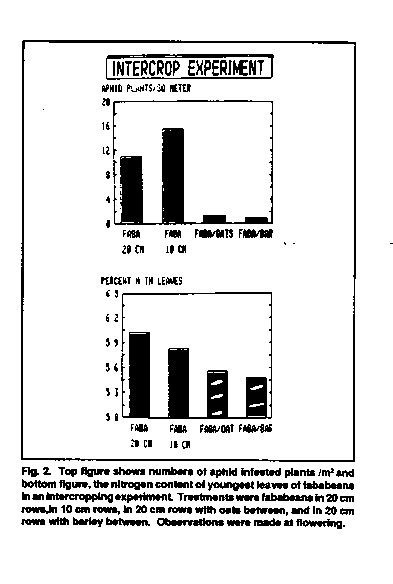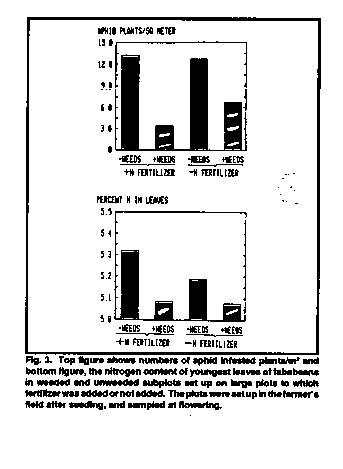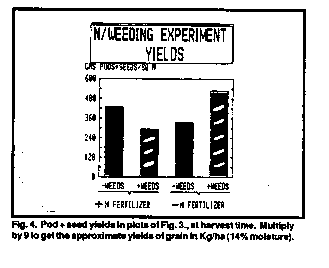
Sustainable Farming Index | Virtual Library | Magazine Rack
Search
| Ecological Solutions Roundtable
By Dr. D. Patriquin
Like humans and non-ruminant livestock, many leaf eating pests are unable to synthesize certain amino acids and therefore must consume them in their diet. When the supply of these essential amino acids is insufficient to allow maximum growth and reproduction, we may say that the pest is "amino acid limited". Under such circumstances, a small increase in the supply of essential amino acids can have dramatic effects on the growth of pest populations, and consequently on pest damage to the crop.
There is evidence that in natural, unfertilized vegetation, amino acid limitation of pest populations is the norm. One way this is demonstrated is by fertilizing plots with nitrogen. Almost invariably, levels of free amino acids and numbers of leaf eating insects are higher on the fertilized plots than in the untreated vegetation. Is it possible, then that use of fertilizer-N contributes to pest problems in agriculture?
A French plant pathologist, Chaboussou, maintains that heavy use of fertilizer-N and pesticides is the principal cause of pest problems in agriculture. Both upset the synchronization between uptake of nitrogen from the soil, and protein synthesis. This results in soluble organic nitrogen accumulating in plant tissues, which makes them more nutritious to pests. High levels of nitrogen fertilizer do it by overloading the system. Pesticides do it by subtle, sublethal effects on protein synthesis of non-target organisms, in this case, the crop. 2,4-D is a prime example. Several independent studies have shown 2,4-D to affect nitrogen metabolism of corn and to cause increases in pests including aphids, corn borer, brown spot and earwomm. Low potassium and deficiencies of copper also increase susceptability to pests by reducing protein synthesis. In chemically intensive farming, says Chaboussou, these factors act in consort to "sensitize" crops to diseases and animal pests.
After reading Chaboussou's theories, I wondered if the low incidence of pests on an organic farm where I was conducting some research could be attributed in part to there being low levels of nitrate in the soil (Nitrate is always low on some organic farms; on others, levels can approach those found in conventionally fertilized farms - it depends on how they are managed.) I was particularly interested in fababeans, a crop I had studied on conventional and organic farms in Nova Scotia. Fababeans can produce exceptional yields in moderate maritime climates, but few farmers grow them, one of the reasons being troubles with aphids.
Basil Aldhouse is one of the few. He planted fababeans in a rotation sequence that went: Oats in year 1 (underseeded with clover) -- clover in year 2 (used as a green manure before planting winter wheat) -- winter wheat in year 3 and fababeans in year 4. The straw from winter wheat was incorporated in the soil by rotovating. The nitrogen-poor straw Immobilized,' or consumed free soil N. which resulted in low levels of soil mineral N under fababeans. This was an intentional strategy to stimulate the fababeans to fix nitrogen from the atmosphere rather than draw on sold N. which was then left behind for oats.
I suspected that it was also one of the reasons why aphids were never a serious problem on Basil's beans. Sometimes there was a heavy settlement of aphids shortly after the beginning of flowering, but the populations peaked and were decimated by predators (Fig 1.) before the pod fill stage when they are potentially most damaging. In 1985, I put 150 Kg/ha of ureaN on 5 large plots in a fababean field just after seeding. As expected, the added N stimulated the aphids: at flowering, there was an average of 3.9 aphid infested plants per square meter in the fertilized plots, compared to 1.8 elsewhere. (Typically there are 25-35 fababean plants per square meter).
What I didn't expect was to find large differences in numbers of aphid infested plants between treatments in experiments that I and several students were conducting for other purposes on this same farm in 1985 and 1986. One of these was an intercropping experiment (Fig 2). There, plots with pure stands of fababeans had 11 times more infested plants than in plots with oats or barley intercrops.
The pure stands in that experiment were much more heavily infested than the pure stands of the farmer's fields. One difference between the pure stands in the intercropping experiment, and the farmer's "pure stands" was that the latter contained lots of weeds, while the former were carefully weeded. As happenstance had it, we were also conducting experiments to evaluate the effects of weeds on crops, and had removed weeds from small (1x1 meter) plots distributed through the farmer's fields. There was an average of 5.4 infested plants per square meter on the weeded plots, compared to 1.9 in the unweeded crop.

In 1986, an experiment was set up to look at interactions of N and weeds on fababeans, and again we observed differences in numbers of aphid infested plants between treatments (Fig 3). In this case, adding N fertilizer did not stimulate aphids, but removing weeds did.
Many other studies have shown that presence of intercrops and weeds can reduce numbers of leaf eating pests on crops by creating habitats for natural enemies, such as ladybird beetles and syrphid flies. However, this could not explain our observations because the natural enemies are highly mobile, and there was en abundance of weeds in close proximity to the weed-free or intercrop-free plots.
Analysis of total nitrogen in leaves of fababeans showed slight but significantly lower N contents in the intercropped or weedy fababeans compared to weeded, pure stands (Fig 2 and 3). This suggests that weeds and intercrops reduced aphid infestations by competing with the crop for N. in turn reducing the concentration of soluble organic nitrogen in phloem fluids, and the nutritional value of those fluids to aphids.
What about crop yields - are the beneficial effects of intercrops and weeds in regard to pests sufficient to overcome the negative effects of competition? The fababean is a legume and could be expected adjustto lower levels of soil N by fixing more N. but weeds or intercrops could still compete with the crop for other nutrients and light.
Yields in the intercropped fababeans were only 4% lower than those in the pure stands. (In this case, the intercrops didn't yield very well; when they do, there is usually more tradeoff in yields of the main crop). In the weeding experiments of 1985, yields of fababeans that were not weeded after planting aver aged 20% lower than those in weed-free plots, while there was no reduction in yield due to weeds where the crop had been harrowed once after emergence.
There were some really interesting effects of weeds in the 1986 experiments: in the presence of N fertilizer, yields in weedy plots were 31% lower then those in weed-free plots, but in the absence of N fertilizer, yields in the weedy plots were 55% higher than those in seed-free plots; the unfertilized, weedy fababeans had the highest overall yields (Fig 4).


Our explanation for the different effects of weeds in the presence and absence of N fertilizer is as follows: background soil nitrate was higher in '86 than '85, because the field was moldboard ploughed in the spring of '86 (in other years, fields were rotovated after harvesting beans). When soil nitrate gets above about 5-10 ppm, nodule formation is reduced. In unfertilized plots, soil N was high enough to inhibit nodule formation early in the season, but not high enough to satisfy crop N requirements later in the season. In weedy plots, weeds reduced N to levels that did not inhibit nodule formation by the fababeans, which then nodulated better than in weed-free plots, and had more N available during pod-fill. In the N-fertilized plots on the other hand, there was enough N to both inhibit nodule formation and to supply most of the crops N requirement; in this case weeds competed with the plant for nitrogen but did not reduce it to levels that promoted nodulation, so the crop did better where it was weeded.
Interestingly, in subsequent studies on another farm where background soil nitrate levels were much higher than at Basil's farm, our studies indicated that left unweeded, fababean yields dropped about 30%, i.e. the same as in the fertilized plots at Basil's. There were also more aphids!
Intercrops or weeds can help to reduce pest problems in fababeans and probably in other leguminous crops in two ways: 1) By increasing diversity and hence living space and food for natural enemies of pests, and 2) By consuming excess nitrogen, thereby making the crop less nutritious to pests and lowering pests' reproductive rates. These two effects are complementary: lower rates of reproduction by pests will result in more effective control by natural enemies.
It also appears that the beneficial effects of weeds on pests are outweighed by their negative, competitive effects when soil N (nitrate and ammonium) is high, but that at lower levels of soil N. some weediness is beneficial. Anything that can be done e.g. use of cover crops before the legumes, working in low N residues, use of legume/ non-legume mixtures or denser planting of the crop, should increase N2 fixation, reduce competitiveness of weeds, and pest problems.
For more details, consult:
F. Chaboussou, 1982. Les Plantes Malades des Pesticides. Editions Debard, Paris, 265 pp.
D. G. Patriquin, D. Baines, J. Lewis and A Macdougall. 1988. Aphid infestation of fababeans on an organic farm in relation to weeds, intercrops and added nitrogen. Agriculture, Ecosystems and Environment. Vol 20:279-288.
Copyright © 1988 REAP Canada
Reprinted with permission. All rights reserved.
Info Request | Services | Become EAP Member | Site Map
Give us your comments about the EAP site
Ecological Agriculture Projects, McGill University (Macdonald
Campus),
Ste-Anne-de-Bellevue, QC, H9X 3V9 Canada
Telephone:
(514)-398-7771
Fax:
(514)-398-7621
Email: info@eap.mcgill.ca
To report problems or otherwise comment on the structure of this site, send mail to the Webmaster